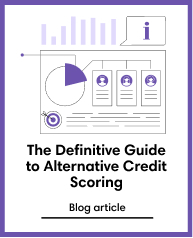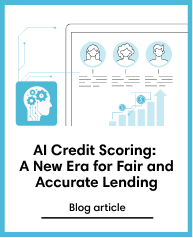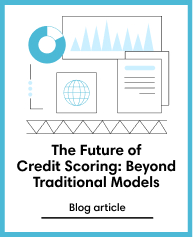Credit Scoring
Jun 11, 2021
How alternative credit scoring helps borrowers build full credit files in USA
Subscribe to our newsletter
According to a 2021 study by University of Essex researcher Peterson Ozili, financial inclusion in the United States (US) is improving significantly and helping eradicate poverty and increase prosperity. The US government has deployed over 800 community development financial institutions meant to boost financial inclusion in the country, especially in rural and distant areas.
Moreover, financial technology or fintech companies are greatly contributing to the modernisation of traditional financial services, finally banking the previously unbanked Americans and enhancing banking services for banked Americans as well. Of course, some of these traditional services are lending and credit scoring.
When you apply for a credit or loan, financial institutions look at different factors to gauge if you’re well-equipped to handle long-term financial responsibilities. One of those factors is, of course, credit score, which is then stored in a credit file, a collection of data about an individual’s credit and payment history. Lenders typically look at credit files to check if borrowers appear to be a good or bad credit risk.
There are three categories of credit files: full file, thin file, and no-hit. Full files refer to credit files with sufficient recent tradeline data to generate a traditional credit score. Meanwhile, a thin file contains insufficient and/or outdated tradeline data to generate a traditional credit score. Lastly, a no-hit refers to the absence of any information or file on the person.
In this blog, we’ll focus on thin files, their relevance in financial inclusion in the US, and how alternative credit scoring comes into play.
What Is a Thin File?
A thin credit file is a credit report of an individual who has little to no formal credit activity. This is often the case for young adults who are just starting out with borrowing money for big investments.
In some cases, parents appoint their teenage children as authorised users on their credit cards to help build their children’s credit files before they turn 18. This can eventually give them a positive credit score once they become adults. As of June 2025, about one-in-four U.S. parents say they have added a child under 18 as an authorized user on their credit or debit card account.
Aside from young adults, people who have thin files are those who have had little need for credit. Others may fall into this group when their accounts drop off their credit reports after seven years due to inactivity.
Most immigrants also experience thin credit files due to the fact that the US measures credit differently from other countries. Even strong repayment data overseas is not usually transferable, leaving newcomers without a meaningful record.
While having a thin credit file differs entirely from having bad credit, it may still prove disadvantageous for loan applicants. Lenders will most likely deny applications if there is little to no credit history to show.
Thus, borrowers must make it a point to turn their thin files into full files if they require credit later. Building activity through small loans, secured cards, or alternative data reporting can help strengthen their profiles over time.
In recent years, credit bureaus and fintech companies have begun incorporating alternative data such as rent payments, utility bills, and mobile phone records into scoring models. This shift helps individuals with thin files demonstrate financial responsibility, offering them a fairer chance to access loans, mortgages, or credit cards.
Who Typically Has a Thin Credit File?
When someone asks, “What is a thin credit file?”, it refers to a credit report containing little or no historical data, often seen among new-to-credit individuals such as young adults or recently banked consumers. Instead of viewing this as a limitation, financial institutions today use machine learning (ML) models and alternative data, like behavioural and device metadata, to better understand these individuals’ creditworthiness, offering fairer and more predictive assessments than traditional models.
According to the Consumer Financial Protection Bureau (CFPB, 2024), around 45 million U.S. adults remain credit invisible or have a thin credit profile, typically containing fewer than four active credit accounts. Immigrants also frequently face this challenge, since their financial histories from abroad are not usually transferable. Individuals who actively avoid debt and rely solely on cash transactions also end up with little recorded credit activity.
In addition, people with dormant accounts may see their records drop off after seven years of inactivity, leaving them with a thin file credit history that fails to reflect current behaviour.
How Does a Thin Credit File Affect Lenders?
From a lender’s perspective, a thin file credit presents practical difficulties. Limited repayment data makes it challenging to assess reliability, often leading to cautious decision-making. Applicants may be declined outright, offered lower borrowing limits, or face higher interest rates to offset perceived risk.
Institutions may also request additional documents, guarantors, or collateral to compensate for the absence of a detailed history. This slows down approval processes and adds friction to customer onboarding. While a thin file credit score does not necessarily indicate poor financial management, the lack of depth restricts lenders’ ability to model default probability accurately.
As a result, thin-filed borrowers face reduced access to mainstream financial products. This creates a cycle where individuals who most need affordable credit are often excluded, reinforcing the importance of alternative data to bridge the gap.
Why Having a Thin File Is Not an Asset
A common question is: “When it comes to credit scores, why is having a thin file not an asset?” The thin file meaning lies in limited visibility, which increases perceived risk for lenders. With too little information, institutions cannot confidently predict repayment behaviour.
This lack of data results in higher interest rates, restricted loan approvals, or complete denials. Even if the applicant has positive financial habits, the absence of a recorded track record works against them.
The solution lies in actively building credit, whether through secured cards, small installment loans, or ensuring regular reporting of alternative payments like rent and utilities. By expanding activity over time, borrowers transition from thin to full files, reducing perceived risk and improving their chances of securing affordable credit.
From Thin File to Full Credit File: What Lenders Look For
To move from a thin to a full profile, borrowers must understand what lenders value. A complete file usually contains multiple active tradelines, such as credit cards, mortgages, or installment loans. It also shows a long repayment history and demonstrates a diverse mix of credit products. Responsible use of credit across time builds trust, making approvals easier and terms more favourable.
Borrowers starting with a thin credit file can strengthen their position by adopting both traditional and alternative strategies. Secured credit cards, small personal loans, or store credit accounts provide conventional pathways. At the same time, timely rent, utility, and mobile phone payments are increasingly incorporated into bureau data, offering valuable signals of reliability.
Over time, these practices build depth and diversity, converting a thin profile into a robust record that supports broader financial access. The shift demonstrates a borrower’s capacity to handle commitments responsibly, which is the core of lender evaluation.
How alternative credit scoring turn thin files into full files
Fortunately, many fintech solutions today make it possible for borrowers to enhance their credit files, raise their credit scores, and eventually borrow money to meet their finance and investment goals. Alternative credit scoring solutions, in particular, prove to be instrumental in this matter, which is good news for Americans today, especially with the new administration.
The U.S. regulatory landscape in 2025 is increasingly focused on data transparency, large-bank oversight, and stronger consumer-credit protections. The Consumer Financial Protection Bureau (CFPB) has advanced new Section 1033 rules under the Dodd-Frank Act, requiring that financial data be shared electronically with authorised third parties.
Regulators also note that pandemic-era payment pauses left gaps in traditional credit histories, reinforcing the need for alternative and behavioural data in modern risk assessment. Privacy-consented, anonymised device and behavioural intelligence—analysed through machine-learning (ML) algorithms—is now central to improving predictive power in credit decisioning, fraud detection, and marketing optimisation.
Credit agencies also see alternative credit data as a way for Americans with low income who are typically locked out of traditional credit to finally raise their credit scores and expand their credit files. In this modern age, alternative credit data has also helped borrowers build digital credit scores, making it more convenient for them to eventually apply for credit or loans.
Fintech companies such as Credolab, for example, use alternative data for embedded credit scoring and bank-grade digital credit scorecards to help typically overlooked borrowers build their credit scores. Its credit scoring solution, CredoSDK, makes it possible for anyone to build a digital credit score, which they can present to the participating bank they’ve chosen to apply to.
With alternative credit scoring solutions just a click away, the possibilities are simply endless for borrowers today.
Evidently, fintech has greatly changed the world for the better, and it will undoubtedly continue to do so as hundreds of nations continue to experience the economic effects of the pandemic. Applying for loans and credit used to be a tedious task, but alternative data and digital credit scoring companies now beg to differ.





